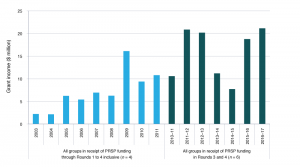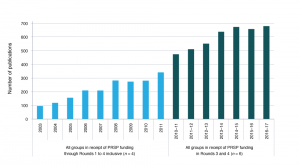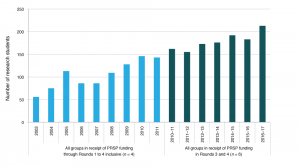Abstract
Objectives: The Prevention Research Support Program (PRSP) is a New South Wales (NSW) Ministry of Health funding scheme. The scheme aims to build capability, and strengthen prevention and early intervention research that is important to the NSW public health system (NSW Health) and that leads to improved health and reduced health inequities for the people of NSW. This paper describes how PRSP funding has supported recipients to produce high-quality, policy-relevant research, and increase the impact of research on policy and practice.
Type of program: The PRSP is a competitive funding program that supports NSW research organisations that conduct prevention and early intervention research that aligns with NSW Health priorities. The objectives of the PRSP are to: increase high-quality and internationally recognised prevention research in NSW; support the generation of research evidence that addresses NSW Health prevention priorities, including cross-government priorities; encourage the adoption of research evidence in relevant policies, programs and services in NSW; and build the prevention research capability of NSW Health staff and the NSW Health system.
Methods: Funding recipients provide information about their research, translation and capability building achievements in their funding applications and submit annual progress reports. Data from these sources were aggregated to illustrate trends in indicators of research excellence over time. Prior to the most recent call for applications, the program was reviewed. The review included consultations with funding recipients, policy and practice partners, and key funding stakeholders. Stakeholders’ perceptions of the benefits and challenges associated with the PRSP were drawn from the consultation data.
Results: PRSP funding recipients demonstrate considerable increases over time on several indicators of research excellence, including peer-reviewed journal publications, grant income, and research students supervised. Recipients use a range of strategies to ensure dialogue with health system partners, and report research impacts at the local, state, national and international levels. PRSP funding also supports the development of research capability.
Lessons learnt: The PRSP is a unique scheme that is highly valued by both funding recipients and health system stakeholders. The continuity of funding provided under the scheme enables recipients to adopt a strategic approach to their research and develop innovative strategies to support its conduct and use.
Full text
Introduction
New South Wales (NSW) Health, Australia’s largest health care system, is committed to the generation and use of population health research with the aim of improving policy and program effectiveness, population health and health equity.1-3 Public health services and programs are provided by NSW Health through a network of Local Health Districts. The NSW Ministry of Health has the role of system manager and guides the development of services and investments in the NSW public health system. As the home of several internationally recognised centres of population health research excellence, NSW is well placed to support a vibrant prevention research community. Building on this existing strength in prevention research, the NSW Ministry of Health’s population health research portfolio comprises different policy focuses and types of investment.4 One such investment is the Prevention Research Support Program (PRSP).
The NSW Health Prevention Research Support Program
In 1996, NSW Health established an Infrastructure Grants Program to ensure equitable allocation of public funds for high-quality research of relevance to health and medical priorities in NSW. The Program represented a new strategic approach to research funding. It was intended specifically to support those research functions not ordinarily funded through project grants and, in turn, to enable research organisations to attract other funds and establish a stable and flourishing research environment and workforce.5 Following a review of the Program that suggested a need to more effectively target research infrastructure funding, the Program stream focusing on population health and health services research was separated from the clinical and biomedical funding streams to form the Capacity Building Infrastructure Grants scheme.6 Since its establishment in 2003 the scheme has undergone regular reviews to assess its performance and identify opportunities for improvement. Scheme enhancements implemented following these reviews have aimed to ensure the scheme’s continued appropriateness and relevance for both recipients (e.g. extending the funding term from 3 to 4 years) and NSW Health (e.g. improving the focus on health system capability development).
The scheme, now known as the PRSP, is now in its fifth funding round. Recipients of the current funding round include a mix of research centres within universities, Local Health Districts and medical institutes.7 These centres are of various sizes, with an average of 42 full-time equivalent research staff (range 21 to 129). Each PRSP funding recipient receives up to $500 000 per year, which may be directed towards research infrastructure, strategies to build research capability, and initiatives to translate evidence from research into policy and practice.
To our knowledge, the structure of the PRSP is unique. Knowledge translation activities supported by funding bodies are typically tied to discrete research projects or programs, and focus on funding application processes (e.g. articulating the relevance of the proposed research) and/or end-of-project activities (e.g. publishing and presenting findings).8,9 Increasingly, funding agencies are supporting research projects that incorporate an integrated knowledge translation approach that requires partnerships between researchers and knowledge users through all stages of the research process.10 The PRSP similarly directs funding towards strategies that support the translation of research evidence into policy and practice. Examples of such strategies include the development of strategic partnerships with research users, coproduction of research, and salaries for staff colocated in research and policy/practice agencies. However, PRSP is not tied to individual projects. Rather, it facilitates a strategic approach to priority-driven knowledge generation and translation across the breadth of prevention research conducted by established research centres.
Another distinctive aspect of PRSP is its focus on prevention research capability development. The NSW Ministry of Health offers a range of research and evaluation development activities11 and supports funded organisations to provide training in research skills. This is in line with the NSW Government push for rigorous evaluation of policies and programs and the development of evaluation capability across the public sector.12,13 The current PRSP funding round placed a greater emphasis on building research capability, with a new objective to “build the prevention research capability of NSW Health staff and the NSW Health system”.14 This increased emphasis is intended to ensure NSW Health staff are better equipped to conduct locally relevant research, assess the quality and relevance of existing research, and leverage other research funding, including from external sources.
Methods
Data related to indicators of research excellence (peer-reviewed research income, peer-reviewed journal publications, number of research staff and students) and factors that enable policy-relevant research (engagement and involvement with NSW Health) were drawn from funding applications and annual progress reports submitted by funding recipients in Rounds 1 (n = 6), 2 (n = 6), 3 (n = 6) and 4 (n = 7).
To explore trends in indicators of research excellence over time, data were aggregated for research centres awarded PRSP funding in successive funding rounds. Four centres were awarded funding in all of the PRSP Rounds 1 to 4, and six centres were awarded funding in both PRSP Rounds 3 and 4.
Data on perceived benefits of PRSP, research translation and capability building were drawn from stakeholder consultations conducted as part of an independent quality assurance review of PRSP in 2015. Consultation participants included researchers from all organisations in receipt of funding during Round 4 (n = 7) and representatives from relevant policy or service branches of NSW Health (n = 6).
Results
Research excellence
Figures 1 to 3 present aggregated data on indicators of research excellence for (a) all four research groups that received funding through PRSP Rounds 1 to 4 inclusive, and (b) all six groups awarded funding in PRSP Rounds 3 and 4. Note that aggregate data depicted for groups (a) and (b) were drawn from different sources and are not directly comparable, but are presented together to illustrate general trends over time.
Collectively, PRSP funding recipients demonstrated considerable increases over time in total research income from peer-reviewed funding sources (Figure 1), peer-reviewed journal publications (Figure 2) and number of research students supervised (Figure 3).
Figure 1. Total peer-reviewed grant income received by recipients of PRSP funding in (a) Rounds 1 to 4 inclusive and (b) Rounds 3 and 4, by year (click to enlarge)
Figure 2. Total number of peer-reviewed journal publications by recipients of PRSP funding in (a) Rounds 1 to 4 inclusive and (b) Rounds 3 and 4, by year (click to enlarge)
Figure 3. Total number of research students supervised by recipients of PRSP funding in (a) Rounds 1 to 4 inclusive and (b) Rounds 3 and 4, by year (click to enlarge)
Researchers participating in the consultations indicated that core infrastructure funding underpinned their ability to conduct high-quality research. Researchers felt that PRSP funding provided welcome stability within a research environment where grant income can vary greatly from year to year. The ability to use PRSP funds to attract and employ high-calibre researchers and key research support staff, such as statisticians who can work across multiple research projects and leverage additional grant funding, was highly valued.
Priority-driven research
All PRSP funding recipients are required to implement strategies to ensure ongoing dialogue with policy stakeholders, including involving NSW Health representatives on a relevant research advisory committee. Other strategies used by recipients included regular discussions with NSW Health staff, over and above advisory committee meetings, to inform planning and research agendas, and consultation with Local Health District staff to keep abreast of local issues. Some recipients described these consultations as integrated into existing health service processes, which also provided the recipients with an avenue to disseminate their research findings. One recipient noted that PRSP:
… has enabled us to engage [with NSW Health staff] more directly and allows us to be seen as associated with NSW Health, which helps to ensure we’re not seen as ‘different’ – our remit is to work with them.
Another recipient described PRSP funds as “the ‘glue’ to build research groups integrated into healthcare”. One innovative example that was seen as particularly effective was a research implementation officer jointly recruited by and colocated with a policy agency. The implementation officer participated in formal and ad hoc policy meetings, gaining insights into the perspectives of experts and stakeholders and sharing knowledge from research.
Research translation
PRSP funding recipients reported a wide range of research translations to health services and programs, mostly at the Local Health District level. These included: technology and safety initiatives; models of care; and disease surveillance, identification and management. An ‘embedded’ model, where researchers spent time in local service settings building relationships and developing a deep understanding of system and service issues, was seen as particularly effective. This approach supported translation efforts by enabling researchers to be directly involved in program implementation, including providing on-the-ground support to implementation staff. Most recipients had also achieved some broader service and program translations at the state, national or international level. There was some evidence of recipients’ work having an impact on policies at the state level (e.g. revision of the NSW Breastfeeding Policy – still underway, and revision of policy on mass vaccinations in severe pandemics15) and beyond (e.g. World Health Organization approach to global surveillance of physical activity16).
Stakeholders acknowledged that the research translations reported were not solely attributable to PRSP funding, but agreed that the scheme’s focus on translation added a dimension to recipients’ work that may not otherwise exist. Dedicated funding for strategies to increase translation (including, for example, partnership development, active dissemination strategies, conference attendance and funding to support visiting academics) is typically not available through other research funding schemes.
Capability building
Several recipients used PRSP funds to directly fund PhD students, employ research fellows, or support and mentor clinician researchers. PRSP funding also supported capability development more indirectly, including by providing research workshops for health system staff, involving clinicians in research programs, and supporting the mentoring of junior researchers and health staff. One recipient described their role as to:
… deliver research for the system and [provide] a resource for others in the system. We use our expertise and ability to foster other research in the health system.
Given the increased focus on health system capability development in the current funding round, it is anticipated that recipients’ activity in this area will continue to expand.
Other benefits and challenges of PRSP
PRSP funding recipients and stakeholders consistently highlighted the unique nature of PRSP funds. It was noted that funding continuity and stability enabled recipients to think strategically about their research programs. They could also explore innovations through pilot research or developmental work, while retaining some flexibility to respond to evolving health system priorities. For example, research support staff employed with PRSP funds supported grant writing and enabled the development of new streams of work. Some stakeholders noted that without the PRSP there would be a much less active population health and health services research sector in NSW.
The development of longstanding relationships between PRSP funding recipients and their policy and practice partners was identified as a mutually beneficial aspect of the scheme. However, such relationships could be challenging for recipients to maintain, particularly where there was high circulation rate of policy staff. Identifying opportunities for engagement activities involving PRSP funding recipients and stakeholders, and more active promotion of the work of recipients across the health system, may help to nurture meaningful partnerships into the future. For example, recipients of the current funding round are encouraged to partner with health system staff to design and undertake applied research funded through the NSW Health Translational Research Grants Scheme.
Conclusion
The PRSP is highly valued by both funding recipients and policy stakeholders for its focus on priority-driven research, the emphasis placed on translation, and the program’s recognition of the need to build infrastructure and capacity to both undertake and leverage high-quality research. Ongoing review, monitoring and refinement of the focus and implementation of the scheme has ensured its continued relevance and appropriateness to both funding recipients and NSW Health.
The PRSP is performing well against its objectives of increasing high-quality research that addresses NSW Health priorities and adopting research findings in health policies, programs and services. Although the research and translation impacts reported here cannot be solely attributed to PRSP funding, stakeholder accounts of how these funds enable the work of recipients do support a link between infrastructure funding provided through this scheme and tangible research-related achievements.
More broadly, the PRSP has a unique and valuable role within the NSW Health research funding portfolio. The scheme is atypical in that it provides infrastructure funds to support and enhance the existing work programs of groups that are producing high-quality, policy-relevant research. PRSP provides funding continuity in an environment characterised by annual variability in grant income. PRSP funding allows recipients to adopt a strategic approach to planning and conducting research, and to develop innovative strategies to support the conduct and use of research.
Peer review and provenance
Externally peer reviewed, commissioned.
Copyright:
© 2018 Stickney et al. This work is licensed under a Creative Commons Attribution-NonCommercial-ShareAlike 4.0 International Licence, which allows others to redistribute, adapt and share this work non-commercially provided they attribute the work and any adapted version of it is distributed under the same Creative Commons licence terms.
References
- 1. NSW Ministry of Health. NSW Health annual report 2016–17. Sydney: NSW Ministry of Health; 2017 [cited 2018 Jul 30]. Available from: www.health.nsw.gov.au/annualreport/Publications/annual-report-2017.pdf
- 2. NSW Ministry of Health. NSW state health plan: towards 2021. Sydney: NSW Ministry of Health; 2014 [cited 2018 Jul 26]. Available from: www.health.nsw.gov.au/statehealthplan/Publications/NSW-state-health-plan-towards-2021.pdf
- 3. Centre for Epidemiology and Evidence. Population health research strategy 2018–2022. Population and Public Health Division. Sydney: NSW Ministry of Health; 2018 [cited 2018 Jul 26]. Available from: www.health.nsw.gov.au/research/Publications/research-strategy-2018-2022.pdf
- 4. Thackway S, Campbell D, Loppacher T. A long-term, strategic approach to evidence generation and knowledge translation in NSW, Australia. Public Health Res Pract. 2017;27(1):e2711702. CrossRef | PubMed
- 5. The Audit Office of New South Wales. Performance audit report: management of research. NSW Health Infrastructure Grants Program: a case study. Sydney: The Audit Office of New South Wales; 1998 [cited 2018 Jul 30]. Available from: www.audit.nsw.gov.au/ArticleDocuments/130/56_Performance_Audit_Report.pdf.aspx?Embed=Y
- 6. Naylor C. Capacity building infrastructure grants workshop. NSW Public Health Bulletin. 2004;15(3):38. PubMed
- 7. NSW Government: Health. Sydney: State of New South Wales NSW Ministry of Health; 2015. Prevention Research Support Program; 2018 Aug 15 [cited 2018 Aug 20]; [about 2 screens]. Available from: www.health.nsw.gov.au/research/Pages/prsp.aspx
- 8. Tetroe JM, Graham ID, Foy R, Robinson N, Eccles MP, Wensing M, et al. Health research funding agencies’ support and promotion of knowledge translation: an international study. Milbank Q. 2008;86:125–55. CrossRef | PubMed
- 9. Smits PA, Denis J-L. How research funding agencies support science integration into policy and practice: an international overview. Implement Sci. 2014;9:28. CrossRef | PubMed
- 10. McLean RKD, Graham ID, Tetroe JM, Volmink JA. Translating research into action: an international study of the role of research funders. Health Res Policy Syst. 2018;16:44. CrossRef | PubMed
- 11. Edwards B, Stickney B, Milat A, Campbell D, Thackway S. Building research and evaluation capacity in population health: the NSW Health approach. Health Promot J Austr. 2016;27(3):264–7. CrossRef | PubMed
- 12. NSW Treasury. Circular TC18-03: program evaluation. Sydney: NSW Treasury; 2018 [cited 2018 Aug 7]. Available from: arp.nsw.gov.au/tc18-03-program-evaluation
- 13. NSW Department of Premier and Cabinet. NSW Government program evaluation guidelines: January 2016. Sydney: NSW Department of Premier and Cabinet; 2016 [cited 2018 Jul 26]. Available from: arp.nsw.gov.au/sites/default/files/NSW%20Government%20Program%20Evaluation%20Guideline%20January%202016_1.pdf
- 14. NSW Ministry of Health. Prevention Research Support Program: information kit for funding, round five – July 2017 to June 2021. North Sydney: NSW Ministry of Health; 2016 [cited 2018 Jul 26]. Available from: www.health.nsw.gov.au/research/Publications/round-5-information-kit.pdf
- 15. Health Protection NSW. Guideline GL2018_008: Mass vaccination clinics during an influenza pandemic. North Sydney: NSW Ministry of Health; 2018 [cited 2018 Aug 22]. Available from: www1.health.nsw.gov.au/pds/ActivePDSDocuments/GL2018_008.pdf
- 16. World Health Organization. Geneva: WHO; 2018. Global Physical Activity Surveillance; 2018 [cited 2018 Aug 22]. Available from: www.who.int/ncds/surveillance/steps/GPAQ/en/





